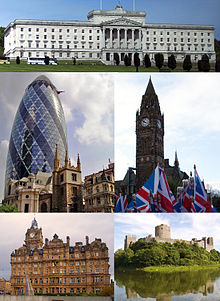
Back Arquitectura del Reino Unido Spanish Միացյալ Թագավորության ճարտարապետություն Armenian Architettura britannica Italian 영국의 건축 Korean Historia architektury angielskiej Polish Arquitetura do Reino Unido Portuguese Архитектура Великобритании Russian Архітектура Великої Британії Ukrainian

Top: Stormont, Northern Ireland
Centre left: 30 St Mary Axe and St Andrew Undershaft
Centre right: Rochdale Town Hall
Bottom left: Balmoral Hotel
Bottom right: Pembroke Castle
The architecture of the United Kingdom, or British architecture, consists of a combination of architectural styles, dating as far back to Roman architecture, to the present day 21st century contemporary. England has seen the most influential developments,[1] though Ireland, Scotland, and Wales have each fostered unique styles and played leading roles in the international history of architecture.[1] Although there are prehistoric and classical structures in the United Kingdom, British architectural history effectively begins with the first Anglo-Saxon Christian churches, built soon after Augustine of Canterbury arrived in Great Britain in 597.[1] Norman architecture was built on a vast scale throughout Great Britain and Ireland from the 11th century onwards in the form of castles and churches to help impose Norman authority upon their dominions.[1] English Gothic architecture, which flourished between 1180 until around 1520, was initially imported from France, but quickly developed its own unique qualities.[1]
Throughout the United Kingdom, secular medieval architecture has left a legacy of large stone castles, with a concentration being found lining both sides of the Anglo-Scottish border, dating from the Wars of Scottish Independence of the 14th century.[2] The invention of gunpowder and cannons made castles redundant, and the English Renaissance that followed facilitated development of new artistic styles for domestic architecture: Tudor style, English Baroque, Queen Anne Style, and Palladian.[2] Georgian, Scots Baronial and Neoclassical architecture advanced after the Scottish Enlightenment, and since the 1930s various modernist forms appeared, though traditionalist resistance movements continue with support from Charles, Prince of Wales.[3]
Beyond the United Kingdom, the influence of British architecture is evident in most of its former colonies and current territories across the globe. The influence is particularly strong in India, Bangladesh and Pakistan[4] the result of British rule in India in the 19th and 20th centuries. The cities of Lahore, Mumbai, Kolkata, Dhaka and Chittagong have courts, administrative buildings and railway stations designed in British architectural styles.[4] In the United Kingdom, a scheduled monument is a "nationally important" archaeological site or historic building, given protection against unauthorised change. A listed building is a building or other structure decreed as being of special architectural, historical or cultural significance; it is a widely used status, applied to around half a million buildings in the UK, enacted by provisions in the Town and Country Planning Act 1947 and the Town and Country Planning Act (Scotland) 1947.
- ^ a b c d e "British Architecture > page 1", Encarta, uk.encarta.msn.com, archived from the original on 31 October 2009, retrieved 18 June 2009
- ^ a b "British Architecture > page 2", Encarta, uk.encarta.msn.com, archived from the original on 31 October 2009, retrieved 18 June 2009
- ^ "Architects to hear Prince appeal". BBC News. news.bbc.co.uk. 12 May 2009. Retrieved 20 June 2009.
- ^ a b Singh et al 2007, p. 69.
© MMXXIII Rich X Search. We shall prevail. All rights reserved. Rich X Search